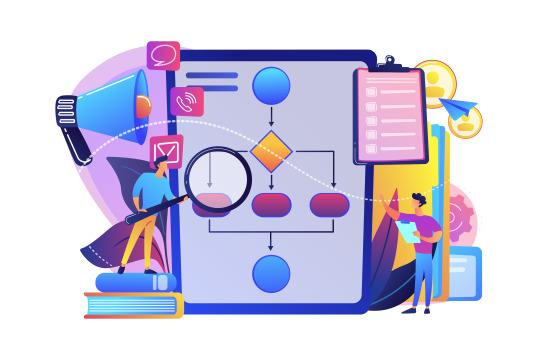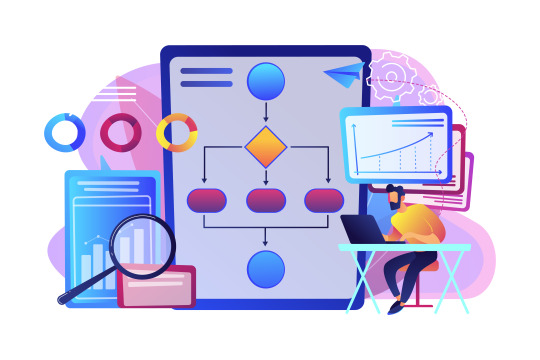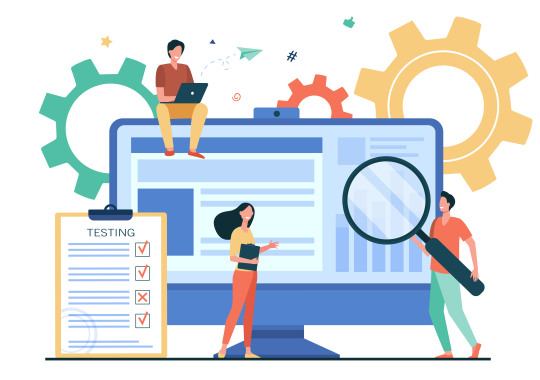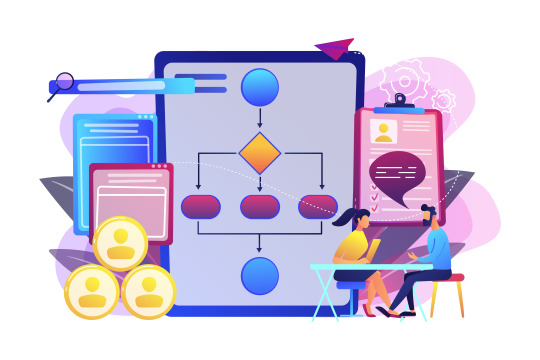Don't wanna be here? Send us removal request.
Text
Streamline Success: The Power of BPA Software
Business Process Automation (BPA) software has become a driving force in modern organizations. In this blog post, we'll explore the power of BPA software and how it can streamline your business processes, boost efficiency, and accelerate success.

Unlocking the Potential of BPA Software
Business Process Automation (BPA) software is designed to streamline repetitive and manual tasks, reducing the need for human intervention. It offers a wide range of benefits:
Efficiency: BPA automates tasks, ensuring they are completed quickly and consistently.
Error Reduction: Automation minimizes human errors, leading to higher accuracy.
Cost Savings: By reducing manual labor and improving efficiency, BPA can significantly reduce operational costs.
Compliance: BPA helps organizations adhere to regulatory requirements by ensuring consistent and auditable processes.
Key Features of BPA Software
Workflow Automation: BPA software allows you to create and automate workflows, ensuring tasks are completed in the right sequence.
Data Integration: Integration capabilities enable BPA software to connect with various systems and databases, ensuring seamless data exchange.
Rules and Logic: BPA software can incorporate business rules and logic to guide decision-making and process execution.
Reporting and Analytics: Advanced reporting tools provide insights into process performance, helping you identify areas for improvement.
Scalability: BPA solutions can scale with your organization's growth, accommodating increased automation needs.
Implementing BPA Software
To harness the power of BPA software effectively:
Identify Processes: Identify which processes can benefit the most from automation.
Select the Right Tool: Choose BPA software that aligns with your organization's needs and goals.
Planning: Develop a clear plan for implementing BPA, including defining objectives and success metrics.
Training: Ensure your team is trained in using the software effectively.
Testing and Optimization: Test automated processes and continuously optimize them for efficiency.
In conclusion, the power of BPA software lies in its ability to streamline operations, reduce costs, enhance accuracy, and improve compliance. By embracing BPA, organizations can achieve sustainable success in today's competitive business landscape.
youtube
SITES WE SUPPORT
Pre Automation Tools – Blogspot
#businessprocessmanagementtools#businessprocessautomationsoftware#procurementprocess#preemploymentaccountingassessment#staffingagencysoftware#Youtube
0 notes
Text
Mastering Efficiency: The Ultimate BPM Tool Guide
Efficiency is a cornerstone of success in today's business world, and mastering it often involves leveraging Business Process Management (BPM) tools. In this comprehensive guide, we'll explore the world of BPM tools and how they can help you achieve operational excellence.

Understanding BPM Tools
BPM tools are designed to optimize and streamline business processes. They provide a structured approach to designing, executing, and monitoring workflows within an organization. Here are key components of BPM tools:
Process Modeling: Tools allow you to create visual representations of your processes, making it easier to identify bottlenecks and inefficiencies.
Automation: BPM software enables you to automate repetitive tasks and ensure consistent execution of processes.
Analytics: Advanced analytics in BPM tools provide insights into process performance, helping you make data-driven improvements.
Collaboration: Many BPM tools offer collaboration features, facilitating teamwork in process improvement initiatives.
Selecting the Right BPM Tool
Choosing the right BPM tool depends on your organization's unique needs. Here are some factors to consider:
Scalability: Ensure the tool can grow with your organization.
Ease of Use: User-friendly interfaces are crucial for successful adoption.
Integration: Look for tools that can seamlessly integrate with your existing systems.
Customization: Consider how well the tool can adapt to your specific processes.
Cost: Evaluate the pricing model and total cost of ownership.
Benefits of BPM Tools
Improved Efficiency: Streamlining processes reduces manual effort and saves time.
Error Reduction: Automation minimizes human errors, resulting in higher accuracy.
Cost Savings: Efficiencies gained through BPM can lead to significant cost reductions.
Compliance: Ensure processes align with regulatory requirements.
Enhanced Collaboration: BPM tools often promote teamwork and collaboration.
Implementing BPM Tools
Successful implementation involves several steps:
Process Mapping: Clearly define existing processes.
Tool Selection: Choose the right BPM tool based on your requirements.
Training: Train your team on the selected tool.
Implementation: Begin by automating one or two processes to gain experience.
Monitoring: Continuously monitor and refine processes.
In conclusion, mastering efficiency through BPM tools is essential for modern businesses. By carefully selecting the right tool and implementing it effectively, you can streamline operations, reduce costs, and achieve sustainable success.
youtube
SITES WE SUPPORT
Pre Automation Tools – Blogspot
#businessprocessmanagementtools#businessprocessautomationsoftware#procurementprocess#preemploymentaccountingassessment#staffingagencysoftware#Youtube
0 notes
Text
Revolutionize Your Recruiting: Staffing Agency Software Solutions
Recruiting top talent is a constant challenge for organizations. Staffing agencies play a crucial role in this process, and leveraging staffing agency software solutions can be a game-changer. In this blog, we'll explore how these solutions can revolutionize your recruiting efforts.

The Role of Staffing Agencies
Staffing agencies specialize in connecting organizations with qualified candidates. They streamline the hiring process, saving time and resources. However, the effectiveness of staffing agencies greatly depends on the tools they use.
Staffing Agency Software Solutions
Applicant Tracking Systems (ATS): ATS systems help agencies manage candidate pipelines, track applications, and streamline communication. They also assist in resume parsing and matching candidates to job openings.
Customer Relationship Management (CRM) Software: CRM software enables agencies to maintain relationships with clients and candidates. It helps track interactions, preferences, and communication history.
Job Posting and Distribution: Software for posting job listings to multiple job boards and social media platforms ensures that job opportunities reach a wide audience.
Candidate Assessment Tools: These tools assess a candidate's skills, personality, and compatibility with company culture, ensuring a better fit for clients.
Analytics and Reporting: Advanced reporting tools provide insights into the performance of the agency's recruiting efforts, helping agencies make data-driven decisions.
Benefits of Staffing Agency Software
Efficiency: These tools automate tasks, reducing manual workload and allowing staff to focus on strategic activities.
Improved Matching: Advanced algorithms and AI in some software solutions enhance the matching of candidates to job requirements.
Compliance: Many solutions include features to ensure compliance with labor laws and regulations.
Enhanced Client Relationships: CRM tools help agencies maintain strong relationships with clients, resulting in more repeat business.
Scalability: As an agency grows, software solutions can scale to accommodate increased demand.
Selecting the Right Software
When choosing staffing agency software, consider factors like your agency's size, the industries you serve, your budget, and the specific features you require. Additionally, look for user-friendly interfaces and robust customer support.
In conclusion, staffing agency software solutions can revolutionize your recruiting efforts by improving efficiency, candidate matching, and client relationships. Investing in the right tools can give your agency a competitive edge in the talent acquisition market.
youtube
SITES WE SUPPORT
Pre Automation Tools – Blogspot
#businessprocessmanagementtools#businessprocessautomationsoftware#procurementprocess#preemploymentaccountingassessment#staffingagencysoftware#Youtube
0 notes
Text
Crunching Numbers and Candidates: Pre-Employment Accounting Assessment
Hiring the right accounting professionals is crucial for the financial health of any organization. Conducting a pre-employment accounting assessment can help you identify candidates with the skills and knowledge necessary for the role. In this blog, we'll explore the importance of pre-employment assessments in the accounting field.

Why Pre-Employment Accounting Assessments Matter
Accounting is a field where precision and expertise are paramount. Hiring a candidate with inadequate accounting skills can lead to financial errors, compliance issues, and reputational damage. Pre-employment assessments help organizations:
Assess Technical Skills: Assessments can evaluate a candidate's proficiency in accounting principles, financial analysis, and software applications like Excel and accounting software.
Gauge Attention to Detail: Accounting requires meticulous attention to detail to avoid errors. Assessments can reveal a candidate's ability to spot discrepancies.
Test Problem-Solving Abilities: Candidates may encounter complex financial problems. Assessments can assess their problem-solving skills and ability to make accurate financial decisions.
Ensure Compliance Knowledge: Accounting professionals must adhere to regulatory standards. Assessments can test a candidate's knowledge of accounting regulations and ethics.
Designing Effective Assessments
Clear Objectives: Define what you want to assess, such as technical skills, problem-solving, or ethics.
Test Variety: Use a mix of question types, including multiple-choice, calculations, and scenario-based questions.
Timed Assessments: Set time limits to mimic real-world pressure and assess time management skills.
Realistic Scenarios: Use real-world scenarios to assess how candidates handle complex accounting situations.
Scoring Rubrics: Develop clear scoring rubrics to ensure fair and consistent evaluation.
Benefits of Pre-Employment Accounting Assessments
Quality Assurance: Assessments reduce the risk of hiring underqualified candidates.
Time and Cost Savings: Identifying qualified candidates early in the hiring process saves time and resources.
Improved Hiring Decisions: Data from assessments helps make informed decisions based on concrete evidence.
Reduced Turnover: Hiring candidates with the right skills decreases turnover rates.
In conclusion, pre-employment accounting assessments are invaluable tools in ensuring that you hire qualified accounting professionals who can contribute to your organization's financial success and compliance.
youtube
SITES WE SUPPORT
Pre Automation Tools – Blogspot
#businessprocessmanagementtools#businessprocessautomationsoftware#procurementprocess#preemploymentaccountingassessment#staffingagencysoftware#Youtube
0 notes
Text
Mastering the Art of Procurement: A Step-by-Step Guide
Procurement is vital for any organization, ensuring the acquisition of goods and services essential for operations. Mastering the art of procurement involves a well-defined process, careful planning, and effective execution. In this step-by-step guide to the procurement process, we'll take you through the critical elements of successful procurement.

Step 1: Needs Assessment
The first step in procurement is to identify the organization's needs. This involves understanding what goods or services are required, their specifications, quantity, and quality standards. A clear needs assessment lays the foundation for a successful procurement process.
Step 2: Supplier Selection
Choosing the right suppliers is crucial. Conduct research, evaluate potential suppliers based on factors like quality, cost, reliability, and ethical considerations. Establishing strong supplier relationships can lead to long-term benefits.
Step 3: Define Requirements
Clearly define your requirements in a Request for Proposal (RFP) or Request for Quotation (RFQ). Include all specifications, terms and conditions, delivery schedules, and any other relevant details. This ensures transparency and reduces misunderstandings.
Step 4: Bidding and Negotiation
Invite bids from selected suppliers and engage in negotiations. This is an opportunity to get the best value for your money while ensuring alignment with your organization's goals.
Step 5: Contracting
Once terms are agreed upon, formalize the agreement in a contract. Ensure all parties understand their obligations, responsibilities, and the consequences of non-compliance.
Step 6: Procurement Execution
Monitor the procurement process, from order placement to delivery, to ensure it proceeds as planned. Effective communication with suppliers is essential to address any issues promptly.
Step 7: Inspection and Acceptance
Inspect received goods or services to ensure they meet the specified quality and quantity standards. Proper inspection helps prevent future issues.
Step 8: Payment and Reporting
Process payments in accordance with the contract terms and maintain accurate records. Reporting and documentation are critical for accountability and audit purposes.
Step 9: Supplier Relationship Management (SRM)
Nurture supplier relationships through ongoing communication and feedback. A positive relationship can lead to better terms and long-term partnerships.
Step 10: Continuous Improvement
Regularly evaluate and improve your procurement process. Identify areas for optimization and seek feedback from stakeholders.
In conclusion, mastering procurement requires a structured approach and attention to detail. By following these steps and continuously improving your processes, your organization can achieve cost savings, efficiency, and strategic advantages through effective procurement.
youtube
SITES WE SUPPORT
Pre Automation Tools – Blogspot
#businessprocessmanagementtools#businessprocessautomationsoftware#procurementprocess#preemploymentaccountingassessment#staffingagencysoftware#Youtube
0 notes
Text
Efficiency Elevated: Exploring Business Process Automation Software
In an era where time is money, businesses are continually seeking ways to elevate efficiency and productivity. Business Process Automation (BPA) software has emerged as a game-changer in achieving this goal. In this blog, we'll explore the world of BPA and how it can help businesses streamline their operations.

Understanding Business Process Automation
Business Process Automation is the use of technology to automate repetitive, manual tasks and processes within an organization. It aims to reduce errors, increase efficiency, and free up valuable human resources for more strategic tasks. Here are some key benefits:
Improved Efficiency: BPA eliminates bottlenecks and reduces the time it takes to complete tasks, resulting in streamlined operations.
Error Reduction: Automation minimizes the risk of human errors, leading to higher accuracy in tasks and processes.
Cost Savings: By reducing the need for manual labor and increasing productivity, BPA can lead to significant cost savings over time.
Enhanced Compliance: BPA ensures that processes adhere to regulations and standards, reducing compliance-related risks.
Exploring BPA Software
UiPath: Known for its Robotic Process Automation (RPA) capabilities, UiPath is a leader in BPA. It's highly customizable and can automate a wide range of tasks.
Automation Anywhere: This BPA software offers intelligent automation solutions, making it easier to automate complex tasks and processes.
Blue Prism: Blue Prism provides a digital workforce that can handle repetitive tasks, freeing up human employees for more strategic work.
Zapier: Ideal for small businesses, Zapier allows you to connect various apps and automate workflows without coding.
Implementing BPA
The implementation of BPA requires a strategic approach. Identify the processes that can benefit most from automation, involve relevant stakeholders, choose the right BPA software, and ensure proper training for your team.
In conclusion, Business Process Automation software can elevate efficiency, reduce costs, and drive growth for businesses. By embracing automation, organizations can stay competitive in a rapidly evolving business landscape.
youtube
SITES WE SUPPORT
Pre Automation Tools – Blogspot
#businessprocessmanagementtools#businessprocessautomationsoftware#procurementprocess#preemploymentaccountingassessment#staffingagencysoftware#Youtube
0 notes
Text
Streamline Success: Top Business Process Management Tools
Business Process Management (BPM) has become a critical component of organizational success. As companies strive to streamline their operations, optimize efficiency, and reduce costs, the choice of BPM tools becomes crucial. In this blog, we'll delve into the world of BPM and explore some of the top tools available.

BPM: A Necessity for Modern Business
In today's fast-paced business landscape, manual processes and disjointed workflows can hinder growth. BPM tools are designed to tackle this problem by offering a comprehensive solution to manage, optimize, and automate business processes. They help organizations achieve consistency, transparency, and agility in their operations.
Top BPM Tools
BPMN.io: This open-source tool is known for its user-friendly interface and collaborative features. It allows teams to model, analyze, and optimize processes easily.
TIBCO BPM: TIBCO's BPM suite offers robust process automation, analytics, and integration capabilities. It's a preferred choice for large enterprises.
Kissflow: Ideal for small to medium-sized businesses, Kissflow provides a low-code platform for process automation. It's easy to use and highly customizable.
Appian: Appian is known for its low-code automation and AI-driven capabilities. It empowers businesses to automate complex processes rapidly.
IBM BPM: IBM offers a comprehensive BPM suite with advanced analytics and AI features. It's well-suited for enterprises with complex workflows.
Choosing the Right BPM Tool
Selecting the right BPM tool depends on your organization's specific needs, budget, and scalability requirements. Consider factors like ease of use, integration capabilities, scalability, and the level of automation required when making your decision.
In conclusion, BPM tools are essential for modern businesses aiming to streamline processes and achieve success. By evaluating your unique requirements and exploring the options available, you can make an informed choice that propels your organization toward efficiency and success.
youtube
SITES WE SUPPORT
Pre Automation Tools – Blogspot
#businessprocessmanagementtools#businessprocessautomationsoftware#procurementprocess#preemploymentaccountingassessment#staffingagencysoftware#Youtube
1 note
·
View note